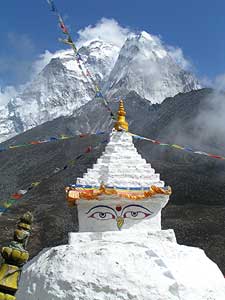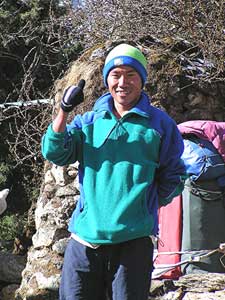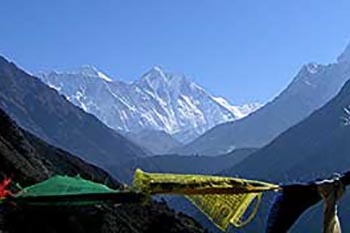

By David Rich
Updated 2020
Everest sat high on the near horizon blowing its nose like a blizzard over the top of neighboring Lhotse, the eternal hurricane-force winds scouring Everest from its west to east summits.
This was the first time I’d seen Everest other than a glimpse from an airplane into Katmandu or Lhasa. This time had taken some doing.
The only way to get to Everest is to fly to Lukla unless you’d prefer a rickety bus to Jiri and a week’s hike from there to reach the Lukla trailhead. Due to the greatly increasing levels of air traffic in Kathmandu, both international and domestic, many of the flights to Lukla are now rerouted through a small municipal airport called Ramechhap.
This about a 4-6 hour drive by bus from Kathmandu and in the past year and a half, it has become the starting point for many of the flights in and out of Lukla. Some trekking agencies are still able to get direct flights, but only a small few.
The flights to/from Lukla are done in order, so the first flight is the earliest (because they cannot give set times for travel, because of the weather) then a second round of flights, and so on. You want to be on the earlier flights during the day as the weather normally changes and clouds move in as the day progresses.
The price of these flights ranges from $160-200 each way. Lukla airport is the third busiest landing strip in Nepal because everyone wants to see Everest up close and some fools actually harbor ambitions to climb Everest or one or more of the dozen other incredible summits in the area.
Don’t Forget to Acclimatize
Many years ago you could have flown into the airstrip above Namche Bazar, but the folks in Lukla complained to the government about their complete loss of business upon the opening of the new airstrip, so you still have to hike from Lukla to Namche, a two-day slog.
The other issue with flying directly into Namche Bazar was that it sits at 11,300 feet, so to fly directly into this altitude without a few days acclimatization is not ideal. The most important factor when going to altitude is making sure that you choose the correct itinerary that gives your body adequate time to adjust to the lack of oxygen.
From Lukla to Everest Base Camp is a minimum of eight days from 9000 to 18,000 feet (3400 to 5400M) including two days off to acclimatize. The acclimatization part is extremely important.
When you hop off the little two-engine plane in Lukla, you’re surrounded by glaciated peaks and would-be porters. Hire a porter. Spend a measly $250 to save your back for twelve or so days, a nice contribution to the local economy, providing a job to a porter that will support his family for six months. Then instead of toting a pack your energy can be expended taking photos National Geographic Magazine would be proud to feature on the cover.
Besides effusive greetings from would-be porters, a medical doctor from London begged me to sign up for a high altitude sickness study coordinated by Stanford University Medical School. Take two capsules a day of what could be Diamox, gingko biloba or a placebo. Check-in with docs in three villages ranging higher and higher in altitude. Cute doc, so I signed up.
Finding a Porter
I found a porter named Raz through Porters’ Progress, a nonprofit repository of clothing and shoes for otherwise ill-clad porters such as Raz.

Raz was a fit-looking twenty-three-year-old quite nice kid and to look at him you wouldn’t think any mountain could impede his progress, contrary to later reality. You see many porters carrying over fifty kilos (110 lbs) wearing flip-flops up near-vertical trails with snow blowing in their faces. When you book with a respected local organization they will limit how much weight a porter can carry, as well as provide better footwear and gear for the journey.
Many of these companies now also use animals to porter the gear, which still provides to the local economy by paying the owner and the porter who manages them.
A Precipitous Plunge
Raz and I dropped down from Lukla into a narrow canyon with Tibetan-style houses perched on sheer hillsides that plunged precipitously to an aquamarine glacier-melt river. If this river were named after the mountain from which it sprang it’d be named Everest, but it isn’t.
The next day we climbed past Sherpa villages primarily consisting of tourist lodges, steeply up to Namche. The hundred or so lodges between Lukla and Base Camp afford hot showers, even in the remotest boondocks and biggest snowstorms, as we found out.
Most have private plywood rooms, two rough frames with foam pads covered by a sometimes-changed sheet upon which you dump your sleeping bag.

There is seldom electric and never any heat except in the dining room where low room charges ($10-50) are cozily recouped over pots of Tibetan milk tea and high-priced food (trucked in by porters).
The menu is fortunately mostly carbs: bread, eggs, potatoes and such, much of it fried, from six to 12 dollars a pop. Eat and stay warm.
The Carter “Suite”
Namche sits at 11,000 feet (3400M), a horseshoe-shaped village of forty-odd lodges where I checked into the Khumbu Lodge, taking Jimmy Carter’s old room (October 1985), which Rosalind must have agreed to inhabit during a fit of bad taste.
Of course, it’s been almost twenty years, so maybe Rosalind had better furnishings than my bare plywood room with two dinky racks barely counterbalanced by lots of windows. The Carter Suite must have been divided into fourths.
The rest/acclimatization day in Namche is often spent exploring its trinket and trekking shops, shopping for goodies from prayer wheels to hiking poles, exploring the river that waterfalls through town center where locals wash their duds in front of signs saying “No Washing Clothes” and listening to a cacophony of stonemasons frantically chiseling gray granite to build Namche’s forty-first lodge badly needed during Nepal’s tourist slump inspired by loose cannon Maoists.
Getting Connected with Everest Link
Today this region has a new solution–Everest-Link, which is a card you can purchase for around $20 that will be used throughout the trek in any lodge that has wi-fi access, which is most of them now. So internet access is generally easily accessible on the trail.
It’s only slightly less disheartening to watch non-tourist porters who supply local merchants, trudging by with half their load consisting of twelve cases of beer and the other half twenty liter canisters of soybean oil: flip flop until you drop.

Portrait Studies of Everest
The real trek to Base Camp begins in Namche where immediately upon leaving town Everest appears on the horizon next to Lhotse, a mere 15 miles (25 km) away, allowing a morning for portrait studies of the highest mountain on earth.
At Tengboche high on a knife-edged ridge the morning views are especially fine, fine with me because half the trekkers turn back here thus leaving the trail far less seriously populated, a major difference on a track pounded into a two-inch (5 cm) dust layer by tourists, porters and yak trains. The dustbowl effect changed abruptly the next day.
Rest Day in Dingboche
The next day was a rest day in Dingboche, to get acclimatized to 14,500 ft (4400M). Raz and I climbed to 4800 meters and then while Raz had an extended tea break at a Chukhung lodge, I pushed the envelope by gasping up another 1300 feet (400M), almost to the brown barren summit of Chukhung Rai.
This climb got me to the highest elevation at which we’d have to sleep in a few days at Gorek Shep, 17,000 feet (5200M), the last village before Everest Base Camp.
I could feel acclimatization seeping into my bones but nevertheless had a small altitude sickness headache on the way down. Raz also admitted to feeling less than perfect. However, by mid-afternoon, we’d kicked the headaches and were back relaxing in Dingboche at 14,500 feet (4400M).
Blizzard Number One
Suddenly a blizzard descended off the lofty tops of Nuptse and Ama Dablam, blanketing Dingboche, turning the village into a springtime winter wonderland and brown yaks white while affording spectacular photography.
The temperature in my room next morning was zero degrees centigrade or thirty-two degrees Fahrenheit, but I’d been comfy in my down sleeping bag and was happy to find no more dust on the trail. Now the trail was pure mud.
Snow flurries began within an hour of leaving Dingboche, adding to the mud and slipperiness of the steep climb to Lobuche’s 1,600 feet (4900M), a mere five miles (eight km) from Base Camp. But upon our arrival, Raz dropped a bombshell. He was high altitude sick, unable to concentrate, migraine headache, weak limbs and he had to get to a lower elevation pronto.
The fact of a fresh blizzard deterred him not at all as he stumbled out of the Lobuche lodge and headed rapidly downhill toward Dingboche. However, Raz had somehow and quite considerately arranged for a substitute porter until we could meet up two days later.

Exhausted Impressions
The next morning Raz‘s surrogate, a kid from the Lobuche lodge, set out on my heels as I began the ultimate four and a half-hour ascent to Base Camp, asking didn’t I really want him to carry my light daypack. I shooed him back to the lodge and said I’d see him in the afternoon.
Never try to speed hike for nine or ten hours between 16,000 and 18,000 feet (4900 and 5400M), even for such a worthy goal as reaching Everest Base Camp and returning to shelter alive. My blaze of exhausted impressions included:
A 15-year old tourist at Gorek Shep unable to remember his name, sure he could recall it if the doc would just give him a couple more hours to think, waiting for a helicopter that if it hadn’t arrived within the hour he’d have been history.
The fog-enshrouded top of Kala Patthar climbed by Jimmy Carter and hundreds of tourists at 1800 feet (5500M) for often superb views of Everest and the surrounding magnificent peaks. I skipped the non-view this day.
A Blaze of Tents
The blaze of pumpkin orange, taxi yellow, baby blue and a cacophony of garish tents dotting the harsh landscape worse than the rockiest river bottom. How could anyone sleep on ice-sharp rocks?
The complete disorganization of Base Camp, which in 2004 consisted of perhaps thirteen or fourteen expeditions to climb Everest. No one knew for sure.
The Envelope, Please
The best rundown on Base Camp came from a chap out of Yosemite, California, Lincoln, who ran the radio link. He told me there were two Korean teams, two from the States, teams from Spain, Chile, Mexico (with two French Canadians) and Canada, the main Irish team down to two climbers including a woman aspiring to be the first of her nationality and sex on top after barely missing it in 2003, two Malaysian climbers with sixteen support staff, a Kiwi contingent and out in front in the sweepstakes to acclimatize and climb Everest first in 2004, the envelope please, and the likely winner was the Greek team in commemoration of Greece hosting the Summer Olympics.
Plus David Braeshears (of Seven Summits fame, the first along with Dick Bass to climb the highest peaks on all seven continents) was running a group called “Working Title”, trying to put together a Hollywood epic on the 1996 Everest disaster memorialized by Into Thin Air and The Climb, radically different versions of what “happened” that killer year on Everest.
Grim Reminders
The tombstones of those dying on Everest form a long line of monuments a half-hour south of Lobuche. Meanwhile, the infamous icefall a few hundred meters from Base Camp, the main initial obstacle to climbing Everest continued to shift, sending down boxcar-sized slabs of ice skittering like a giant train disaster.
At least one expedition had given up and gone home, perhaps good sense overtaking foolishness, its climber’s victim to high altitude, berserk icefalls or the exquisite pleasure of sleeping on razor-sharp rocks at Base Camp, which I then bid adieu.
I’d guess far fewer than half the trekkers who enter Samarantha (Everest) National Park make it to Base Camp because most suffer from mild to very severe high altitude sickness, food poisoning, giardia or half a dozen other readily available and debilitating maladies.
In 2000 over 25,000 people entered the Park. However, only 13,786 checked in during 2002 though the numbers climbed back over 19,000 in 2003. I was happy to be among those to have actually made it to Base Camp though I had to battle the third blizzard in as many days back to Lobuche. I was even happier the next day after scampering back down to a reasonable altitude to find Raz, my weenie Sherpa porter, fully recovered but overdue for a lecture on acclimatization.
Thanks to Ian Taylor who helped us update this story. He runs a tour operation to the base of Everest.
- Mali: Djenne, Vivid Colors and Timbuktu - February 28, 2024
- Pantanal, Brazil: Dozens of Magnificent Creatures - September 17, 2019
- David Rich: The Monkey on My Back to See it All - November 12, 2018




One of my dreams was to trek from Lukla Top Base Camp and eventually attempt the ultimate climb. Not Going to happen. in 2014 I developed bone cancer and lost my Leg above my knee. Had the amputation been below my knee I would have attempted the inevitable. I enjoy reading how others have traversed the mountains and valleys in Nepal. What a beautiful country.